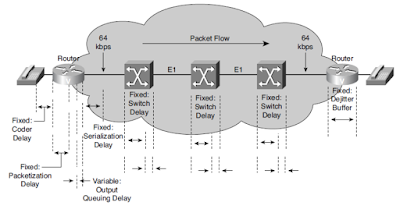Bandwidth management is a must
We
are used to having fast and reliable networks in our companies where
many times bandwidth management is not necessary because we have
enough bandwidth for our users and services. However, this is not
always possible due to the fact that enterprise bandwidth is
expensive and budget is limited. As a result, network engineers have
to guarantee bandwidth for some services like VoIP, video
conference or mission critical services and
manage bandwidth properly. Today, there are
Software-Defined WAN
appliances like IWAN
from Cisco or SteelConnect
from Riverbed which allow us to
have application visibility, WAN and LAN optimization, traffic
control, etc to speed up and control our business network.
If
we want to have a good network performance, we should understand what
are the enemies of Quality or Services (QoS). First of all, a lack of
bandwidth is the main issue when multiple streams of voice and data
traffic is competing for a limited amount of bandwidth. Secondly,
there are many kind of delays that we should take into account like
fixed delays, that we can't change, variable delays, that we can
change with queuing and priorities, and delay variations as jitter.
By last, packet loss is something that
we have to manage too
for dropping and discarding those packets less important.
 |
| Sources of Delay |
If
we want to have a good network performance, we'll have to apply QoS
policies and shaping as well. The first
step is to identify traffic and its requirements, which can be done
with network analyser tools. The second step is to group traffic into
classes. For example, voice traffic into a low latency class, or
e-commerce and web browsing into a mission-critical class with
guaranteed traffic. The last step is to define QoS policies for each
traffic class where we'll set a minimum bandwidth guarantee, a
maximum bandwidth limit, we'll assign priorities to each class, we'll
use QoS technologies, such as advanced queuing, to manage congestion,
etc.
 |
| Group traffic into classes |
We
have to take into account that traffic management, congestion
management and congestion avoidance is not only for WAN link but LAN
as well. Therefore, we don't just have to
install SD-WAN
appliances on the border of our network but, maybe, we should
configure QoS inside our LAN too. Maybe, we should know about CoS for
Ethernet frames and DSCP for IPv4 packets to classify and mark our
applications if we want to queue them into a Low Latency Queue (LLQ),
Weighted Fair Queue (WFQ) or FIFO queue. It's
mandatory to know how many queue the devices have and how to use
them.
On
the other hand, if we have a Metro
Ethernet or MAN, or we work for a
network service provider, we'll have to guarantee traffic between
branches or customers. Then, MPLS with RSVP and RSVP-TE will be
mandatory for reservation of resources across the network.
Regards
my friends, and remember … network traffic management is a must for
big networks.









Commentaires
Enregistrer un commentaire